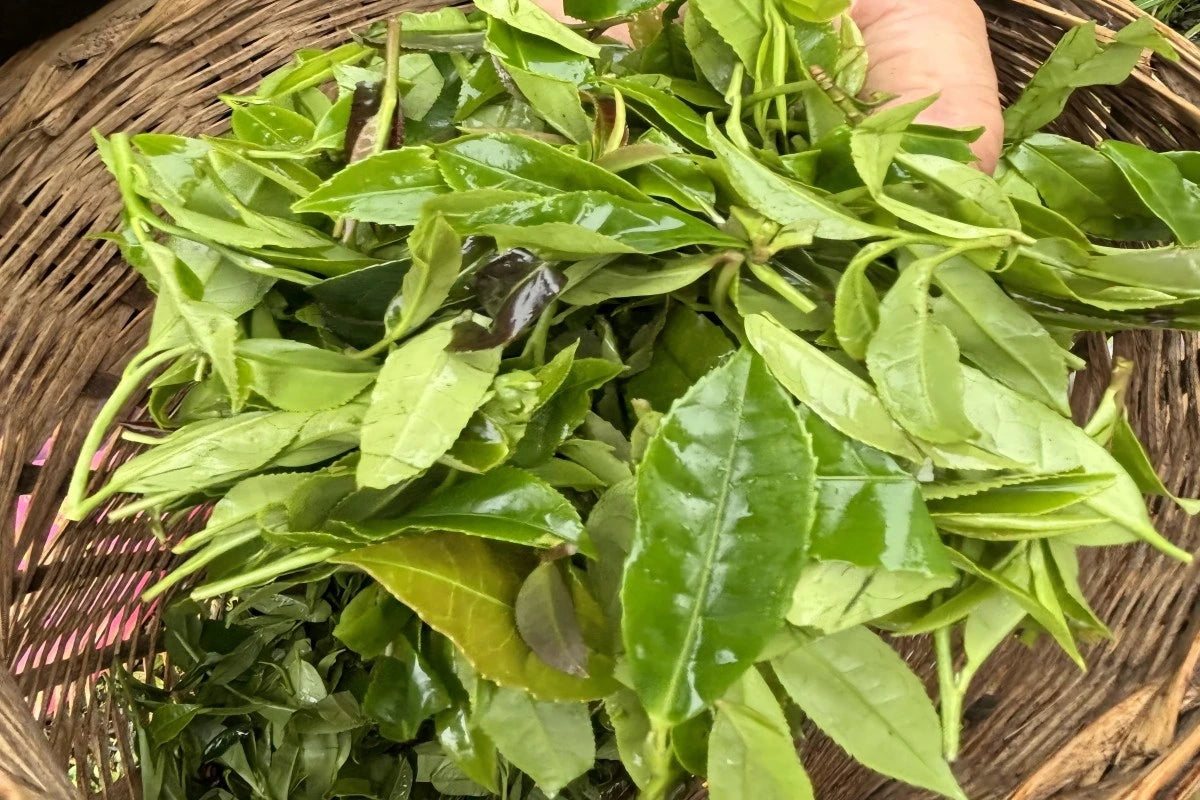There are plenty of factors that can affect the taste and flavor of green tea, including differences in manufacturing processes, tea plant varieties, harvesting levels, and the growing environment of the tea plants. For instance, steamed green teas, like Gyokuro, have a distinct seaweed flavor; pan-fired green teas, like Longjing, have a notable roasted nut aroma; in terms of tea plant varieties, Longjing made from the 'Wuniu Zao' cultivar lacks the typical bean fragrance because of the specific variety used; looking at the harvesting levels, Longjing with one bud and one leaf has a more refreshing taste and a more elegant aroma.
On the other hand, Chinese Tea, specifically Longjing with one bud and three leaves, has a less distinct aroma and isn’t as refreshing. Today, we’re using two renowned varieties of Chinese Tea, Longjing and Huangshan Maofeng Green Tea, to illustrate the differences between green teas of various harvesting levels.

Longjing Green Tea (Dragon Well Tea):
Longjing Green Tea, a prized selection within any tea gift set, hails from the West Lake region in Hangzhou, Zhejiang Province. With a history stretching back to the Tang Dynasty, it has been celebrated in Chinese literature and is renowned for its unique flat leaf shape, smooth texture, and vibrant green color. The tea leaves boast a distinct “bean flower” aroma and a fresh, sweet taste that lingers on the palate, making it a cherished inclusion in any tea gift set. The best Longjing Green Tea, such as the “Pre-Qingming” or “Daughter’s Red,” is meticulously picked before the Qingming Festival, a time when the leaves are at their most tender and flavorful, often featured in premium tea gift sets.
Longjing Green Tea, often regarded as the best green tea to drink, is closely associated with the beauty of West Lake and is considered a liquid reflection of the region’s natural splendor. It is said that even the Qianlong Emperor, during his southern tours, praised this particular tea, which he deemed the best green tea to drink, and designated a specific plot of tea plants as “Imperial Tea” due to its exceptional quality.
Huangshan Maofeng Green Tea (Yellow Mountain Fuzzy Tip):
Huangshan Maofeng Green Tea is a delicate green tea that originates from the Yellow Mountains in Anhui Province. This tea is known for its curled leaves covered in white down, resembling a sparrow's tongue, with a hue that is greenish-yellow and a fragrance reminiscent of orchids. The tea has a sweet, mellow taste and a lingering aftertaste that is both refreshing and satisfying.
Huangshan Maofeng Green Tea is meticulously hand-crafted from the tender shoots of selected tea varieties grown in the misty mountainsides, which are picked during the clear and grain rains around the Qingming and Guyu seasons. The tea's name, "Maofeng," which translates to "fuzzy peak," refers to the white tips that adorn the tea leaves, symbolizing the peak of the Yellow Mountains where it is sourced.
Longjing and Huangshan Maofeng Green Tea are both famous green teas from China, each with their own unique flavor profiles. These flavors are influenced by a variety of factors, including the tea plant variety, growing conditions, harvesting levels, and processing techniques. Here's a look at the flavor differences between different leaf grades of Longjing and Huangshan Maofeng Green Tea.
Longjing Green Tea Flavor Variations by Leaf Grade:
-One bud and one leaf Longjing Green Tea: This is a higher grade of Longjing Green Tea. The leaves are tender, with plump and straight buds, offering a fresh and invigorating taste and a clear, high aroma. Because the leaves are more delicate, they may not be as enduring when brewed, but the taste and aroma are exceptional.
-One bud and two leaves Longjing Green Tea: Compared to the one bud and one leaf, this grade of Longjing Green Tea has a higher endurance for brewing and a richer taste. Its aroma remains fresh, but you might notice a bit more depth in the flavor profile.
-One bud and three leaves Longjing Green Tea: This type of Longjing Green Tea has more mature leaves, resulting in a stronger flavor and better endurance for brewing. The aroma might not be as uplifting as the younger leaves, but it still maintains the unique, fresh fragrance of Longjing Green Tea, with a fuller mouthfeel.
Huangshan Maofeng Green Tea Green Tea Flavor Variations by Leaf Grade:
-One bud and one leaf Huangshan Maofeng Green Tea: This is a premium grade of Huangshan Maofeng Green Tea tea. The leaves are delicate, with a green and moist appearance, featuring golden yellow fish leaves, commonly called "golden slices". The tea soup is clear and bright, with a fresh taste and an elegant aroma, embodying the classic style of Huangshan Maofeng Green Tea.
-One bud and two leaves Huangshan Maofeng Green Tea: This grade of Huangshan Maofeng Green Tea offers a richer taste and improved endurance for brewing. Its aroma might not be as delicate as the one bud and one leaf grade, but it still retains the fresh fragrance characteristic of Huangshan Maofeng Green Tea, with a more concentrated flavor.
-One bud and three leaves Huangshan Maofeng Green Tea: With more mature leaves, this grade of Huangshan Maofeng Green Tea has a richer flavor and better endurance for brewing. The aroma might be more subdued compared to the younger leaves, but it still preserves the fresh fragrance of Huangshan Maofeng Green Tea, with a smoother mouthfeel.
In summary, different leaf grades of Longjing Green Tea and Huangshan Maofeng Green Tea, both exquisite examples of green tea Chinese, each have their unique flavor profiles.
Younger leaf grades of green tea Chinese typically possess a higher aroma and a more refreshing taste, while more mature leaf grades of green tea Chinese offer a richer flavor and better brewing endurance.
These differences in green tea Chinese are not only influenced by the leaf grade but are also closely related to the tea plant variety, growing environment, and processing techniques.

Summary of Green Tea Grades:
One bud and one leaf green tea:
Quality: It's often seen as the cream of the crop because the buds are super tender and packed with goodies.
Taste: It's super fresh and sweet, with a delicate flavor profile.
Aroma: The scent is elegant and long-lasting, often with a refreshing hint of greenness or a bean-like aroma.
Brew durability: It's on the lower side because the leaves are so tender and don't stand up well to long infusions.
One bud and two leaves green tea:
Quality: It's high-quality, striking a balance between the tenderness of the bud and the maturity of the leaves.
Taste: The flavor is rich and fresh, with a more complex and robust mouthfeel compared to one bud and one leaf.
Aroma: The aroma is still fresh but a bit more intense than the one bud and one leaf variety.
Brew durability: It fares better than the one bud and one leaf green tea, standing up to multiple infusions.
One bud and three leaves green tea:
Quality: It's more mature in quality, with a bolder flavor.
Taste: The taste is strong, and it has the best brew durability, but it might not be as refreshing as the one bud and one leaf or one bud and two leaves green teas.
Aroma: The aroma could be more subdued, with a richer layering as the leaves mature.
Brew durability: It's the best, thanks to a higher content of polyphenols and caffeine, making it a favorite for tea lovers who prefer a strong flavor.
Harvest Time:
One bud and one leaf green teas are usually picked early in spring when the tea plants are nutrient-rich, resulting in top-quality leaves. One bud and two leaves, and one bud and three leaves green teas are harvested mid-to-late spring.
Appearance:
One bud and one leaf green teas have the most uniform appearance with plump buds and an aesthetically pleasing shape. As the number of leaves increases in one bud and two leaves, and one bud and three leaves green teas, the appearance becomes slightly more robust.
Processing Techniques:
Different grades of green tea might be processed differently to highlight their characteristics. For example, one bud and one leaf green teas might require more delicate killing green and drying techniques.
Market Positioning:
One bud and one leaf green teas are typically positioned in the high-end market, while one bud and two leaves, and one bud and three leaves green teas cater more to everyday drinking needs.
In a nutshell, one bud and one leaf green teas are loved by tea enthusiasts for their tenderness and high quality. One bud and two leaves green teas strike a good balance between quality and price. One bud and three leaves green teas are perfect for those who prefer a bold flavor and high brew durability.
If you're curious about the different grades of Longjing and Huangshan Maofeng Green Tea, check out 6 Flavors Superior Green Tea Leaf Grade Collection .Includes Longjing And Huangshan Maofeng Green Tea 87G For Morning,that's all about exploring how the leaf grade of green tea affects its flavor, aroma, and the overall tea-drinking experience. This series features two famous Chinese green teas—Longjing and Huangshan Maofeng Green Tea—both made from traditional renowned tea plant varieties.
The only difference is the leaf grade. You'll get to taste three different grades:
One bud and one leaf
One bud and two leaves
One bud and three leaves Each tea is hand-picked and processed by the same skilled tea master to ensure consistency in craftsmanship. By sampling these subtle variations in leaf grade, you'll gain a deeper understanding of green tea and find the grade that best suits your personal taste.
What would be the best water temperature for brewing green tea of different grades?
When brewing green tea of different grades, there are indeed different suggestions for water temperature, which helps bring out the best flavor of the tea. Here are some basic guidelines:
One bud and one leaf green tea: This high-quality green tea is very delicate, so it's recommended to use a slightly lower water temperature to brew it. This prevents the tea from becoming bitter due to high temperatures. The ideal water temperature is around 70°C to 75°C.
One bud and two leaves green tea: Compared to the one bud and one leaf, this green tea has a higher tolerance for brewing and a richer taste. Its aroma is still fresh, so a slightly higher water temperature is suggested, around 75°C to 80°C, to fully extract the tea's flavor.
One bud and three leaves green tea: This green tea has more mature leaves, a stronger flavor, and better brewing tolerance. Its aroma might not be as uplifting as the younger leaves, but it still maintains the unique fresh scent of green tea. For these more mature leaves, a slightly higher water temperature can be used, around 85°C, to bring out a richer taste.
In general, tender leaf grades of green tea are usually recommended to be brewed with a lower water temperature (70°C to 75°C), while mature leaf grades can handle a slightly higher temperature (up to 80°C-85°C).
These differences are not only influenced by the leaf grade but also closely related to the tea plant variety, growing environment, and processing techniques. Using an electric kettle with temperature control can easily help you manage the water temperature, ensuring that each brew reaches the ideal temperature.

The caffeine levels in green tea can vary depending on the leaf grade.
The amount of caffeine in the best green tea is influenced by a bunch of factors, like the type of tea plant, how it’s grown, when it’s picked, which parts are picked, and how it’s processed. Generally, the younger the leaves in the best green tea, the more caffeine they have. That’s because the tea plant pumps up the caffeine in the tender buds to keep pests away.
When it comes to green teas made with one bud and one leaf versus one bud and three leaves, the caffeine difference is mostly about the maturity of the leaves.
Green tea with one bud and one leaf is usually made from the tea plant's tender buds and the first leaves that unfold. These leaves have a higher caffeine content because the buds and young leaves need the most protection, so the plant makes more caffeine to ward off bugs.
On the other hand, green tea with one bud and three leaves has more mature leaves. These mature leaves have less caffeine because as the leaves get older, they're better at fighting off pests, so they don't need as much caffeine.
Specifically, when you brew green tea with one bud and one leaf, more caffeine dissolves into the water. This means it can give you a better boost, but it might also be a bit harder on your stomach because of the higher caffeine content. Green tea with one bud and three leaves has more mature leaves, so it has less caffeine and might be easier on your stomach, but it might not give you as big of an energy boost as the one bud and one leaf variety.
In summary, green tea with one bud and one leaf usually has more caffeine, while green tea with one bud and three leaves has less. This is mainly due to the difference in the maturity of the leaves.











































































